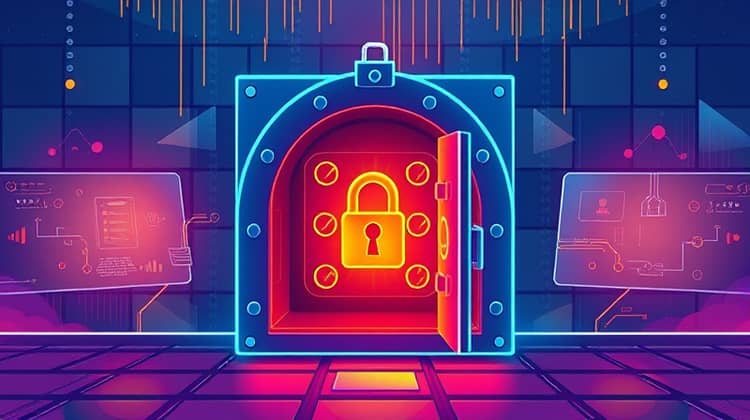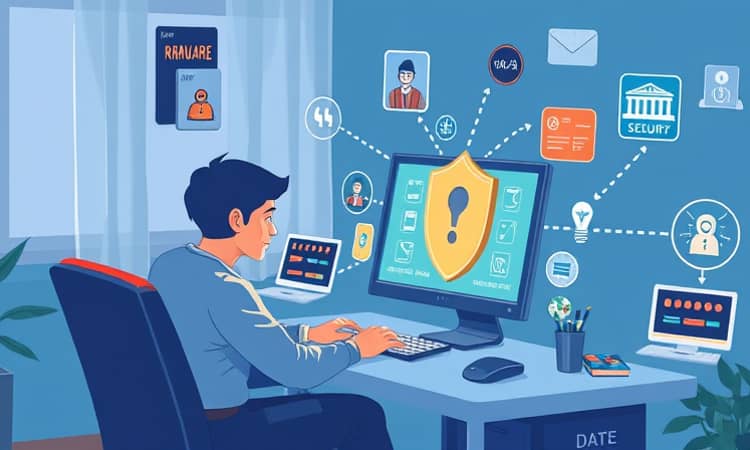Online banking offers convenience that has transformed how individuals manage their financial lives. With the ability to perform transactions, check balances, and even apply for loans from the comfort of home, it's important to recognize that this convenience comes with its own set of risks. As online banking becomes more popular, so do the various threats that target users.
Understanding these threats and how to mitigate them is crucial to ensuring the safety of your financial information. In this article, we will delve into common online banking threats and provide useful tips on how to protect your accounts effectively. We'll outline notable threats such as phishing, malware, and data breaches, followed by actionable steps you can take to enhance your online banking security.
Common Online Banking Threats

As online banking has become ubiquitous, criminals have also adapted their tactics to prey on users who may not be aware of the risks they face. Understanding these threats is the first step in securing your financial information as you conduct transactions online.
The most common threats can be categorized into various types such as phishing, malware, and data breaches. Each of these poses unique risks that can lead to financial loss and identity theft, making it essential for online banking users to be informed and alert.
1. Phishing

Phishing is a deceptive technique where attackers impersonate legitimate organizations to obtain sensitive information, such as login credentials and credit card details. This usually happens through emails or messages that look authentic but contain malicious links or attachments designed to lure unsuspecting users.
In recent years, phishing attacks have become increasingly sophisticated, utilizing social engineering tactics that create a sense of urgency or fear. For example, users might receive messages claiming there is suspicious activity on their account, urging them to act quickly, often leading to hasty decisions that compromise security.
To combat phishing, it's essential to be cautious about unsolicited communications. Always verify the authenticity of requests for sensitive information by contacting the organization directly through official channels rather than clicking links provided in potentially fraudulent messages.
2. Malware

Malware, or malicious software, refers to programs designed to infiltrate or damage a computer system without the user's consent. In the context of online banking, malware can capture keystrokes or access sensitive information stored on a user's device, such as bank account details.
Common forms of malware include keyloggers, trojans, and ransomware. Each of these can result in significant financial loss as attackers gain access to sensitive banking information. Users often unknowingly download malware by clicking on infected links or visiting compromised websites, making vigilance crucial.
Regularly updating software and using trustworthy security solutions can help protect against malware. Awareness of the signs of infection is also important, as users must act quickly to mitigate damage if they suspect that malware may have infected their devices.
3. Data Breaches

Data breaches occur when unauthorized individuals gain access to confidential information stored on a company’s servers. This can include sensitive personal and financial information, putting customers at risk for identity theft and fraud. With the increasing number of data breaches reported every year, understanding this threat is paramount.
Banking institutions can be prime targets for data breaches due to the treasure trove of sensitive data they hold. When a breach occurs, consumers may not be immediately aware that their information has been compromised, leaving them vulnerable to further attacks.
To enhance security, it is crucial for users to take proactive steps, such as regularly monitoring their financial statements for unauthorized transactions and using services that provide alerts for suspicious activity on their accounts.
Tips for Protecting Your Online Banking Account

Protecting your online banking account requires diligence and a proactive approach. Fortunately, there are a number of strategies that users can implement to increase their security and safeguard their financial information. Implementing these tips can provide peace of mind while conducting transactions online.
Consider adopting a multi-layered approach that incorporates strong passwords, two-factor authentication, and regular monitoring of account activity. These measures go a long way in securing your accounts and identifying any irregularities quickly when they arise.
Additionally, it's important to stay informed about the latest threats and security practices. Cyber threat landscapes are constantly evolving, and being proactive about your security can significantly reduce your vulnerability to online banking threats.
- Always verify emails and messages before clicking on any links or attachments
- Use a reputable security software to scan for threats regularly
- Educate yourself about the latest types of online banking threats
Always remember that the best defense against online threats is a combination of awareness and proactive behavior. By staying vigilant and informed, users can take significant steps in protecting their online banking accounts.
1. Use Strong, Unique Passwords

One of the most critical defenses against unauthorized access to your online banking account is using strong and unique passwords. Many individuals tend to reuse passwords across multiple accounts, which can be a significant security risk if one of those accounts is compromised.
A strong password typically consists of a mix of uppercase and lowercase letters, numbers, and special characters. It should be at least 12 characters long and not contain easily decipherable information like birthdays or names. These characteristics make it far harder for potential attackers to gain entry into your account by guessing or using brute-force methods.
It's also essential to update your passwords regularly and consider changing them immediately if you suspect a security breach. By maintaining unique passwords for each of your online accounts, you can significantly reduce the chance of multiple accounts being compromised at once.
Given the complexity of managing numerous strong passwords, consider using a password manager. A password manager can help generate and store your passwords securely, making it easy to maintain unique credentials across various platforms.
2. Enable Two-Factor Authentication (2FA)

Two-factor authentication (2FA) adds an extra layer of security to your online banking account by requiring not only your password but also a secondary verification method, typically a code sent to your mobile device or email. Enabling 2FA considerably decreases the likelihood of unauthorized access even if someone obtains your password.
This method works by ensuring that even if a hacker manages to guess or steal your password, they would still need access to the secondary verification method to get into your account.
Many banking institutions and online services now offer 2FA as a standard feature. It's advised to enable this feature wherever possible to greatly enhance the protection of your online banking and other sensitive accounts.
3. Be Wary of Phishing Scams

As previously highlighted, phishing scams remain a significant threat to online banking security. The growing sophistication of these scams means that it is crucial for users to stay alert and informed about common tactics utilized by cybercriminals.
Typically, phishing attacks involve sending emails, text messages, or direct messages that appear to be from legitimate institutions. These communications may ask users to verify their account information, reset their passwords, or click on enticing yet malicious links.
Always scrutinize the sender's email address, look for grammatical errors, and be cautious about unsolicited requests for personal information. If in doubt, directly contact your bank through official channels before taking any action based on unexpected communications.
4. Keep Your Software Up to Date

Keeping your device's software and applications up to date is a vital component of maintaining online banking security. Cybercriminals often exploit vulnerabilities in outdated software to gain unauthorized access to systems and sensitive information.
Regularly updating your operating system, web browsers, and security software helps protect against the latest threats and vulnerabilities. Most updates provide critical security patches that address known issues that could be exploited by malicious actors.
Consider enabling automatic updates on your devices to ensure that you are always protected by the latest security features and improvements. This simple practice significantly enhances your device’s defenses against emerging threats.
- Always install updates for your operating system and software immediately
- Set software to automatically update whenever possible
- Regularly review and update security settings to optimize protection
By ensuring your devices are secure and up to date, you make it much more difficult for attackers to exploit existing weaknesses in your system.
5. Monitor Your Account Regularly

Regular monitoring of your online banking account is essential for identifying any suspicious activity or potential fraud at the earliest possible stage. By checking your account often, you can quickly spot unauthorized transactions and take prompt action to report them to your bank.
Look for any unfamiliar transactions, no matter how small, as these can indicate that your account has been compromised. In such instances, it's important not to ignore even minor discrepancies, as they may be signs of larger fraudulent activities.
Many banks now offer notifications for transactions, which can serve as an efficient way to keep track of your account activity in real-time. Opting into these notifications ensures you are alerted to transactions as they occur, allowing you to act quickly if something seems off.
6. Use a Secure, Private Network

Using public Wi-Fi networks for online banking can pose significant risks, as these networks are often less secure and can be easily compromised. If you must access your online banking account on a public network, take precautions to protect your sensitive information.
A secure, private network reduces the chances of cyber attacks and data interception. If you need to access your banking information on the go, consider using a virtual private network (VPN) to encrypt your connection, adding an additional layer of security.
Using a personal mobile data connection instead of public Wi-Fi is another way to ensure that your sensitive bank information remains safe and secure.
- Avoid accessing your online banking account on public Wi-Fi networks
- Utilize a VPN when accessing sensitive accounts over a public connection
- Only enter sensitive information when using a secured, encrypted connection
By prioritizing secure connections, you help safeguard your banking information from potential interception by malicious actors.
7. Avoid Using Public Wi-Fi for Banking

As mentioned earlier, public Wi-Fi networks are notoriously vulnerable to security breaches. Whenever possible, refrain from accessing your online banking accounts while connected to these unsecured networks, as they can expose your sensitive information to cybercriminals.
If you must use public Wi-Fi, try to ensure that you are connected to a trusted network, and avoid conducting any financial transactions unless necessary. Always prioritize a private network to ensure secure connections whenever feasible.
8. Log Out and Close the App When Done

Logging out of your online banking app after completing your transactions is a simple yet effective habit that can greatly enhance your security. It prevents any unauthorized access to your account should someone else gain access to your device.
Just like you wouldn't leave a bank without securing your belongings, it's crucial to apply the same principle online. Logging out ensures that your session ends securely and that your information is not left exposed.
Closing the app after logging out further ensures that inadvertent access is minimized. Always make it a point to establish these practices to reinforce your account security.
- Close all banking apps after use
- Clear the browser history regularly if you access banking via a web browser
- Ensure that you log out of sessions before leaving your device unattended
Incorporating these habits into your daily activities contributes to a more secure online banking experience overall.
9. Be Aware of Social Engineering

Social engineering is a manipulation tactic used by attackers to trick individuals into divulging confidential information. This can happen through phone calls, emails, or even in-person interactions aimed at gaining personal information and access to accounts.
Being vigilant and employing critical thinking when interacting with unfamiliar individuals is important. Always verify requests for sensitive information through official channels, and never fall victim to pressure tactics that compel you to act quickly without confirming legitimacy.
Understanding the signs of social engineering, such as unsolicited requests or pressure to provide information, can help protect you from falling victim to such schemes.
10. Be Cautious with Account Recovery Information

Account recovery information, including security questions and backup emails, often serves as a gatekeeper to your accounts. Therefore, it is crucial to treat this information with the same level of security as your password.
Avoid using easily guessable answers for security questions – instead, consider using random or nonsensical answers that only you would remember. This deters potential attackers from easily gaining access to your accounts by exploiting this information.
Additionally, review your recovery information periodically to ensure it remains up to date and secure. Any changes in your contact details should be reflected in your account settings.
Conclusion

As online banking continues to thrive, remaining vigilant against potential threats is of utmost importance. By adopting the outlined strategies, you can significantly strengthen the defenses of your financial accounts and minimize risks associated with online banking.
Always remember the importance of awareness and proactive behavior; the combination of both can make all the difference in protecting your sensitive information. Regularly auditing your security practices can also help you adapt to new threats as they emerge.
Implementing even simple measures can create a more secure online banking experience, allowing you to enjoy the conveniences of digital banking while mitigating risks.














